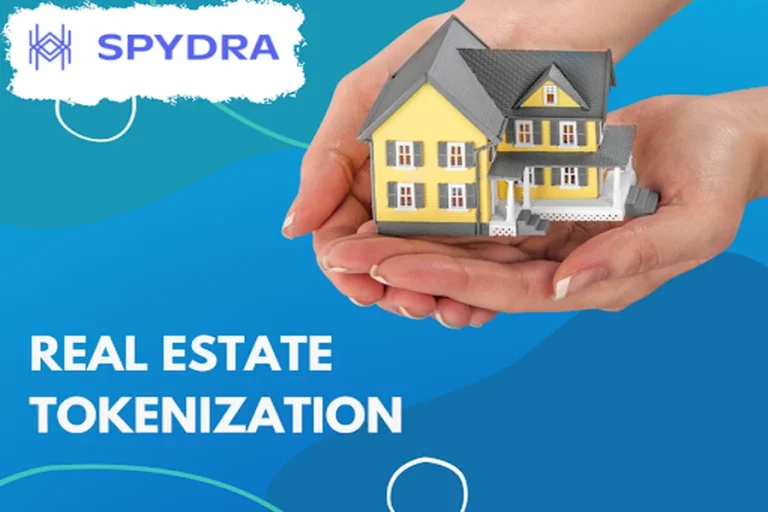The global real estate tokenization market is projected to hit $1.4 trillion by 2030 (Market Research Future). That’s not just a number—it’s a revolution in the making. By converting real estate assets into blockchain-based tokens, investors gain fractional ownership, instant liquidity, and borderless access to property markets. Spydra, leveraging Hyperledger Fabric for its enterprise-grade blockchain infrastructure, is driving this transformation by making real estate investing more transparent, secure, and inclusive than ever before.
What is Real Estate Tokenization?
Real estate tokenization is the process of converting physical property—residential, commercial, or industrial—into digital tokens stored on a blockchain. Each token represents a share of the asset, giving investors partial ownership rights.
Instead of buying an entire building or plot, investors can purchase tokens equivalent to as little as $100 worth of the property. This fractional approach makes real estate investment more accessible, especially to small and mid-sized investors who traditionally couldn’t afford prime real estate assets.
Why Real Estate Tokenization Matters Today
Real estate has always been seen as one of the most stable asset classes. But it also comes with major hurdles:
- High entry costs
- Lengthy transactions
- Lack of liquidity
- Opaque ownership records
Tokenization changes the game. According to Deloitte, tokenized assets could represent 10% of global GDP by 2030, which equates to around $16 trillion in tokenized markets. Real estate will be one of the largest beneficiaries of this trend, thanks to its size, stability, and demand.
Spydra’s Role in Real Estate Tokenization
Spydra isn’t just another blockchain platform—it’s an enterprise-grade tokenization solution built on Hyperledger Fabric. This blockchain framework provides privacy, scalability, and robust security, making it perfect for real estate use cases where compliance and trust are critical.
Here’s how Spydra empowers stakeholders:
- Fractional Ownership: Breaking down assets into small tokens for mass accessibility.
- Global Reach: Investors worldwide can participate without the usual geographical barriers.
- Automated Compliance: Smart contracts ensure every trade meets regulatory standards.
- Instant Liquidity: Token holders can trade on secondary markets, unlocking funds quickly.
By leveraging Hyperledger Fabric, Spydra ensures enterprise clients get permissioned blockchain networks, secure data handling, and regulatory-grade transparency.
Benefits of Real Estate Tokenization
1. Accessibility for All
Tokenization lowers the barriers to entry. A small investor in India can own part of a New York skyscraper without dealing with intermediaries or cross-border hurdles.
2. Liquidity Boost
Traditionally, selling real estate could take months. With tokenization, secondary markets enable instant trades, giving investors liquidity like never before.
3. Transparency and Security
Every token transaction is recorded on the blockchain, ensuring tamper-proof ownership records and reducing fraud. Hyperledger Fabric’s permissioned ledger adds another layer of auditability and trust.
4. Diversification Made Easy
Instead of locking funds into one property, investors can spread risk across multiple tokenized assets globally.
5. Cost Efficiency
Tokenization removes intermediaries, cuts paperwork, and reduces transaction costs significantly.
Market Trends and Growth Projections
- $1.4 Trillion by 2030: The real estate tokenization market is expected to grow at a CAGR of 50%+ over the next decade (MRFR).
- $16 Trillion Tokenized Assets: As per Boston Consulting Group, 10% of global GDP will be tokenized by 2030.
- Blockchain Adoption: A PwC survey reveals over 42% of financial institutions are exploring tokenization.
These numbers highlight the unstoppable momentum toward tokenized real estate as a mainstream investment class.
How Spydra Stands Out
Unlike generic tokenization platforms, Spydra focuses on enterprise adoption. Its differentiators include:
- Regulatory Compliance: Tools to comply with SEC, RBI, and local jurisdictional laws.
- Customizable Tokens: Support for both security tokens and utility-based property tokens.
- Smart Contract Automation: From dividend payouts to rental income distribution.
- Scalable Infrastructure on Hyperledger Fabric: Capable of handling thousands of assets and millions of investors.
This positions Spydra as the preferred partner for institutions, developers, and investors seeking secure and scalable real estate tokenization.
Real-World Example: Tokenized Commercial Property
Imagine a $20 million commercial property in Mumbai. Through Spydra’s tokenization platform:
- The asset is divided into 20 million tokens, each worth $1.
- Investors from around the world purchase tokens digitally.
- Rental income is distributed automatically via smart contracts.
- Token holders can sell or trade their shares instantly on a secondary exchange.
This example shows how tokenization transforms real estate into a liquid, global, and transparent asset class.
Challenges in Real Estate Tokenization
Of course, no innovation is without challenges:
- Regulatory Hurdles: Different countries have varying laws for tokenized assets.
- Technology Barriers: Blockchain adoption is still nascent in traditional industries.
- Market Education: Many investors remain unaware of tokenized real estate opportunities.
Spydra addresses these by offering compliance-first infrastructure, seamless onboarding, and educational resources—all underpinned by Hyperledger Fabric’s enterprise-grade blockchain framework.
The Future of Real Estate Tokenization
The road ahead is crystal clear—tokenization isn’t a passing trend; it’s the future of real estate investing. Analysts believe that by 2030, over 25% of global real estate transactions could involve tokenized assets.
As Web3 adoption grows and investors demand more transparency, tokenized real estate will become the default investment choice. Platforms like Spydra, powered by Hyperledger Fabric, will play a pivotal role in making this trillion-dollar opportunity accessible to all.
Final Thoughts
Real estate tokenization by Spydra is not just about innovation—it’s about redefining ownership, liquidity, and access. With a projected market size of $1.4 trillion by 2030, tokenized real estate is a goldmine waiting to be tapped.
For investors, it means lower entry costs and higher liquidity. For developers, it means raising funds faster. And for the global economy, it means democratized access to one of the world’s largest asset classes.
The question isn’t whether real estate tokenization will dominate—but whether you’ll be part of the movement early enough to reap the rewards.
FAQs
- What is real estate tokenization?
It’s the process of converting real estate assets into blockchain-based digital tokens that represent ownership shares. - How does Spydra use Hyperledger Fabric?
Spydra leverages Hyperledger Fabric to build permissioned, secure, and scalable blockchain networks that ensure compliance and trust in real estate tokenization. - Is tokenized real estate legal?
Yes, in many jurisdictions, provided platforms comply with securities regulations. Spydra integrates compliance into its system. - What are the benefits of real estate tokenization?
Fractional ownership, liquidity, transparency, lower transaction costs, and global accessibility. - How big is the tokenized real estate market?
It’s projected to reach $1.4 trillion by 2030, growing at a CAGR of over 50%.

